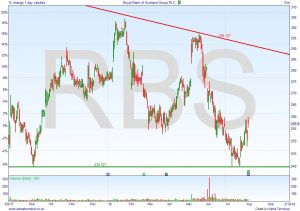This report is not a personal recommendation and does not take into account your personal circumstances or appetite for risk.
After a ten-year £45bn bailout-enforced hiatus, Royal Bank of Scotland (RBS) has finally reinstated a dividend. This signals confidence in future profitability, suggesting that massive restructuring, to shrink what was once, briefly, the biggest bank in the world, is almost complete and that long-running troublesome US litigation is water under the bridge. It’s even talking about bigger dividends (paying out 40% of profits) and share buybacks.
In fact, it’s a very similar path to that trodden by Lloyds (also bailed out; £20bn) which returned to profitability (2013), the government then selling an initial tranche of shares (£3.3bn, at a loss to the taxpayer; Sept 2013), before dividends were resumed (Feb 15), allowing the government to gradually sell down its 43% stake (completed May 2017), and the bank to launch a £1bn share buyback (Mar 2018).
Resuming the dividend and offering a yield/income could give RBS shares a near term boost, allowing them to be once again owned by certain institutional investors. Talk of buybacks may also give them support in terms of a forced buyer. However, don’t forget that the government is still trying to sell down its 62.4% stake (already down from 70.4%), meaning the threat of future sales. In June it sold a 7.7% stake, worth £2.6bn, at a small discount to the market price and a loss to the taxpayer. Sound similar?

That said all this talk of dividends and buybacks does remain contingent on the bank finalizing its settlement with the US Department of Justice for pre-crisis mis-selling of what turned out to be toxic mortgage backed securities. Remember them from 2008, kicking off the global financial crisis? We would be suprised if the bank wasn’t 99% certain that this is a done deal. Dividends are the last bastion for a company, only cut when financials go really sour, and only resumed when sure they can be maintained . After a decade waiting, shareholders wouldn’t take to kindly to another cut, would they?
So 2p might not sound a lot. At 0.78% of the current share price it’s hardly a generous income, but it’s better than nowt. And it’s only the interim dividend. There should be another in Feb. If it’s another 2p, that implies an annual yield of 1.5%. Again not exactly competitive versus other UK Index constituents. But what did Lloyds resume its dividend with back in early 2015? A 0.75p dividend on a 75p share price equated to…… 1%. And it offered the same six months later for an annual yield of 2%. Twelve months later, it even returned to paying a bigger dividend for the second half of the year, just like RBS used to. Lloyds also paid special dividends in 2016 and 2017, and, seeing as you ask, at 62.8p it now pays just over 3p, yielding holders 5.4% per annum.

Could RBS be set to follow a similar, or even the same, schedule/time-line? Should shareholders prepare for more profits, higher dividends, special dividends and even supportive share buybacks, while the government tries to drip feed its bailout stake back into the market without disrupting the price?
With RBS shares at 258p, having bounced 7% from July’s 240p lows, might investors be so bold as to ask whether revived near-term interest in a bank which used to yield 7.5% (Lloyds used to yield 10%!) could help the shares back to recent highs (295p)?
Much like Lloyds, does today’s RBS dividend news mark the end of a bailout saga and beginning of a new era of more shareholder friendly growth and income? If you are either holding RBS, or watching them with a view to buy, get access to our award-winning research and stay in the loop about all that moves the shares, from news to dividends to buybacks and government stake sales, we cover it all.
If Knowledge is Power and both Power and Time are Money, take two mins to get yourself in the know and take control of your trading/investing.
Enjoy another sunny weekend.
Mike van Dulken, Head of Research, 3 Aug 2018
This research is produced by Accendo Markets Limited. Research produced and disseminated by Accendo Markets is classified as non-independent research, and is therefore a marketing communication. This investment research has not been prepared in accordance with legal requirements designed to promote its independence and it is not subject to the prohibition on dealing ahead of the dissemination of investment research. This research does not constitute a personal recommendation or offer to enter into a transaction or an investment, and is produced and distributed for information purposes only.
Accendo Markets considers opinions and information contained within the research to be valid when published, and gives no warranty as to the investments referred to in this material. The income from the investments referred to may go down as well as up, and investors may realise losses on investments. The past performance of a particular investment is not necessarily a guide to its future performance.
Prepared by Michael van Dulken, Head of ResearchComments are closed.